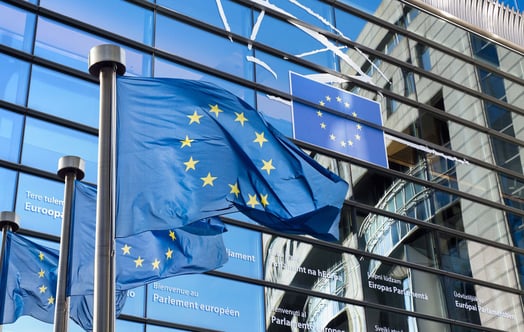Vattenfall has set a target to recycle all dismantled wind turbine blades by 2030, and 50 percent of the blades already by 2025. Turbine blades from Dutch Wind farm Irene Vorrink will be the first to enter the recycling process and turned into skis, snowboards and construction materials for solar farms.
Gustav Frid, Senior Environment & Sustainability Specialist at Vattenfall, sees the recycling of the turbine blades from Irene Vorrink Wind Farm primarily as a pilot project.
"First of all, we want to learn from this process and see which companies are suitable to help us recycle the wind blades. We believe that there is no single solution for this, but rather a number of different ones. Because Vattenfall has proven to be a leader in sustainability in recent years, many companies want to collaborate with us, and they are contacting us."
Skis and snowboards
Marcin Rusin, co-owner at Gjenkraft in Norway, recognises himself in these words. "We were looking for partners for our wind blade recycling project, came into contact with Vattenfall and since then we have been in constant contact with Gustav Frid about the progress of the work in our project. When the wind turbines of the Irene Vorrink wind farm were dismantled, we were one of the first to offer to recycle the wind blades."
Recycling wind turbine blades is specialist work, as they have a complex structure.
"The blades consist not only of resin and glass or carbon fibre, but also of balsa wood, PVC or PET foam, other polymers and metals. It is almost impossible to separate the individual components, so they have to be processed together. This complicates the recycling process and the possibility of recovering residual value from the blades," says Marcin Rusin.
Gjenkraft recovers glass and carbon fibres, depending on the type of blade.
"In the recycling process, we can adjust the parameters to obtain the properties that our customers expect from our products. Our products are used again to make skis or snowboards and other products that contain glass fibres and carbon fibres."

Skis made of recycled wind turbine blades. Photo: Gjenkraft
Solar panels and agriculture
Based on the results of the EU project LIFE Carbongreen which studied recycling of carbon fibre composites, Professor Gregor Luthe says: "Wind turbine blades are designed to withstand extreme loads, so they consist of strong fibres of glass and carbon that are bound by duro-plastics. We have managed to make new duro-plastics that can be used in the construction materials of so-called agrophotovoltaics, solar panels placed above or among agricultural products. With our material, we replace the steel and aluminium of the construction. Both these raw materials use a lot of energy in their production and are now also very scarce due to the war in Ukraine."
In one fell swoop, BillionPeople, the company founded by Professor Luthe, achieves many goals with this method: 100 per cent recycling of wind blades, saving CO2, building solar parks with recycled materials, producing renewable energy, increasing yields, and improving the climate.
“Finally, our goal is to have a fully commercial application as early as 2025 enabling Vattenfall to reach its 100 per cent target much sooner than 2030."

New T-piece construction material suitable for PV parks
Drone inspections
However wind turbine blades do not have to be completely dismantled to have a second life, explains René de Moor, aircraft systems teacher at MBO College Airport.
"We want to offer our students an even broader field of knowledge and that's how we came to wind turbines, because wind blades naturally have a lot to do with aircraft technology. We contacted Vattenfall and told them we wanted to train people for them. When asked what we needed for that, our answer was: knowledge, apprenticeships, and equipment. We had already bought a small nacelle simulator and we were still looking for other parts of the wind turbine." Before the MBO college got hold of two wind turbine blades from Wind farm Irene Vorrink, they had to provide a good motivation, but that was no problem. "One of the blades will be placed at MBO College Airport, where we will look specifically at the construction of the wind blade. How is it put together and how does it work exactly? The second wind blade will go to the Drone Engineering & Operations course in Valkenburg. They will use drones to inspect the wind blade. The drone can also attach itself to the blade and conduct minor repairs with a spay," says an enthusiastic René de Moor.
Gustav Frid from Vattenfall is excited about the different parties Vattenfall is now working with: "Both recycling and reuse play a key role in the development of sustainable industrial solutions."

Robin van Buchem, Head of Operations NL at Vattenfall, hands over one of the wind turbine blades to Philip Mol, President of MBO College Airport. Photo: Goulmy Design & Photography
Environmental focus Vattenfall
Ensuring and enabling sustainable use of resources is one of Vattenfall’s environmental focus areas.
The target and efforts to enable recycling of wind turbine blades contribute to our overall ambition by demonstrating that Vattenfall is determined to redefine how we work with resources, moving away from linear flows (take-make-use-dispose) towards circular management of resources.




